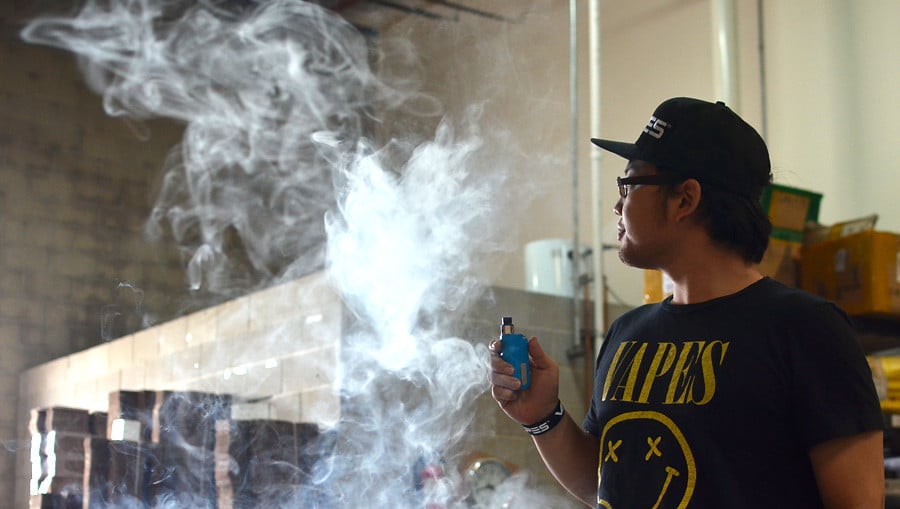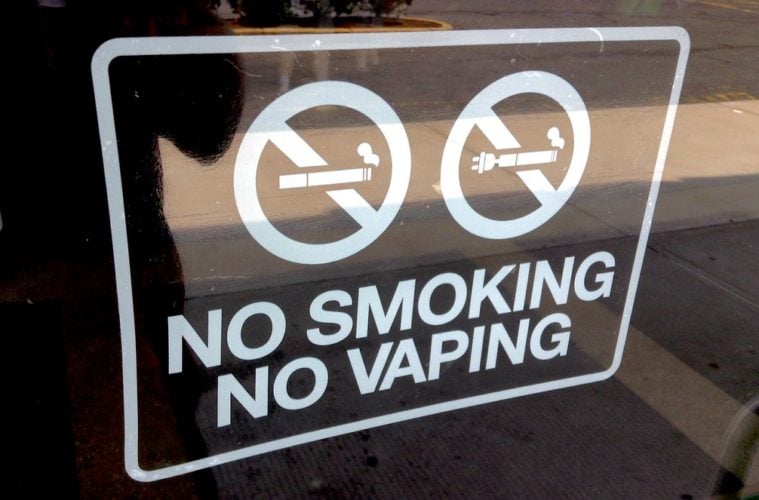The number of victims of the vaping crisis in Los Angeles has doubled since October as vape sales in the legal cannabis industry have taken a massive hit from the ongoing public health crisis.
According to the newest data out this week from Arcview Market Research and BDS Analytics, vape sales have plummeted in recent months following the crisis entering the news cycle. In just two months, sales dropped by $41 million across the U.S. This was on the heels of sales reaching an all-time high of $160 million last August.
The sales plummet is a direct result of the outbreak of the e-cigarette, or vaping, product use-associated lung injury scare across the nation, the Centers for Disease and Prevention call it EVALI for short. According to the CDC’s New Year’s Eve update, as of December 27, 2,561 cases of hospitalized EVALI events or deaths had been reported in all 50 states and tow U.S. territories. The confirmed death toll has reached 55 in 27 states, and more deaths that could be attributed to EVALI are also under investigation.
Los Angeles County recently warned residents to stop vaping again, as they have for months. According to the County of Los Angeles Department of Public Health, as of January, 2, 36 cases of serious vaping-associated pulmonary injury and one death have occurred in Los Angeles County. The number of local cases has more than doubled since we originally reported on the crisis in October, with almost two-thirds of the cases are occurring in people under the age of 25.
“All but one reported using both an e-cigarette and a cannabis-type product, not necessarily at the same time. One reported using flavored liquids only (no nicotine, THC or CBD). Various devices and products were reported and remain under investigation,” the health department said in the statement, “No specific vendor, product or substance has been identified as the cause.”
According to BDS Analytics’ GreenEdge data tracking system, things were going pretty awesome for vapes in the eight months leading up to the crisis in Arizona, California, Colorado, Nevada and Oregon. Those months followed a year in 2018 where vape sales across the markets BDS Analytics tracks totaled $1.6 billion.
Before the scare, the market was projected to grow to $2.5 billion in 2019 and then up to $10.6 billion by 2014. But sales plummeted 21 percent to $126 million in September and a further 5 percent in October to $119 million. By the end of September, even before the October dip, all previous guesstimates on the value and growth of the vape market over the next few years had been tossed in the trash.

(Vapes.com)
“The data in this report is incontrovertible; consumers want to vape, but want to do so safely,” said Troy Dayton, CEO of The Arcview Group, in a statement on the report’s release. “The fear of vaping illicit, dangerous products has put a damper on this segment of the cannabis industry. It is incumbent upon both the federal and state governments to put into place a regulatory regime that protects consumers and advocates for highly-regulated, third party-tested concentrates.”
Some of the report’s other takeaways included the fact that vape sales neared 25 percent of all product sales across Arizona, California, Colorado, Nevada and Oregon over the first three-quarters of 2019. Here in California vapes continue to be wildly popular since being introduced to the market roughly 10 years ago. For the first time, vapes beat flower sales for a month in October 2018.
The nation’s oldest marijuana reform organization believes the crisis is proof a national standard needs to be set.
“The outbreak of illnesses related to certain additives in THC vaporizer cartridges makes it clear that it is imperative that we move towards regulation and legalization in every state in this country,” NORML executive director Erik Altieri told us. “The overwhelming majority of cases related to these additives were from products purchased on the unregulated market, where sellers are incentivized to make the most money they can, as quickly as possible, regardless of what that means for the health of their customers or the quality of their products. Cannabis oils and related substances sold on the streets are not subject to scrutinous testing and quality standards.”
Altieri also noted that states with legalized cannabis markets moved quickly to ban the additives the CDC deduced were the cause of most of these health issues and consumers can largely feel confident in purchasing regulated and tested products from state-licensed dispensaries.
“Legal and regulated does not mean there will ever be zero risk of issues, people still get sick and die from E. Coli in lettuce, but it greatly decreases the chances of adulterated, dangerous products getting into the hands of consumers and makes it possible to quickly and thoughtfully react when certain issues do ultimately arise, ” Altieri said.
“Vapes have not just been the legal cannabis industry’s fastest-growing major product category, but also the focus of some of its most creative product-development and marketing initiatives,” said Tom Adams, editor-in-chief of Arcview Market Research and Managing Director of BDS Analytics Industry Intelligence. “The popularity of vaping is central pillar of our forecasts of the future growth of cannabis sales, so it’s crucial for cannabis industry professionals to understand the impact the vape crisis will have on the market, and how to best adjust business strategies in its wake.”
The authors emphasized in their breakdown of the data covered by the report that the deaths were largely the result of consuming illicit market cannabis vape products, not those from the tested and regulated legal cannabis markets. “In any case, the EVALI crisis underscores the importance and urgency behind making cannabis legal nationwide and enacting a comprehensive regulatory framework that enables further elimination of the illicit market,” they said.
Arcview and BDS Analytics believe that whether the trend will continue into 2020 and beyond depends on the testing of EVALI patients and the development of testing protocols for legal vapes despite the lack of blame on that segment of the market. State regulators could also play a major role in how all this plays out as seen when the Massachusetts vape ban by Governor Charlie Baker that recently failed in the courts.
They also said the most important part of how all of this will play out is whether consumers who were previously inclined to purchase cheaper vapes from the illicit market will decide to purchase from legal sources. But as prices come down the further we head down the legalization path, there will certainly be less financial incentive to buy on the black market. Apart from saving a few bucks, the main perk right now of buying at licensed dispensaries is not dying.
We reached out to the National Cannabis Industry Association to get their take on the new data.
“It’s really unfortunate that conscientious, regulated providers are taking this financial hit in the market, especially considering it was onerous financial burdens making it difficult to displace the illicit market that contributed to this outbreak in the first place,” NCIA media relations director Morgan Fox told L.A. Weekly, “That being said, it is incredibly fortunate that, for the most part, policymakers seem to have realized that this issue is coming almost entirely from the illicit market and do not appear to be pursuing misguided total bans of regulated vaping products any longer.”
Fox thinks we’ll start to see sales stabilize and rebound as more consumers recognize this fact, “but it will only be sustainable if state and federal lawmakers start treating the industry fairly so that it can offer competitive prices for these products.”
Advertising disclosure: We may receive compensation for some of the links in our stories. Thank you for supporting LA Weekly and our advertisers.

